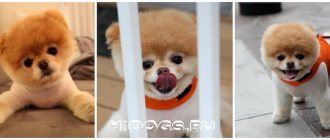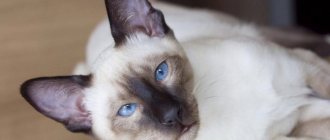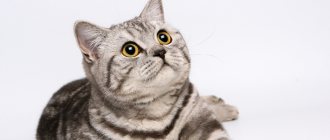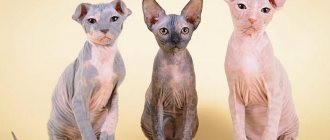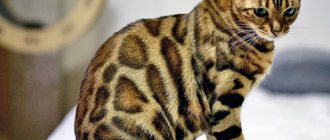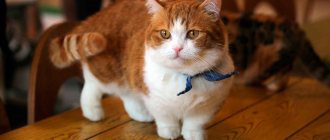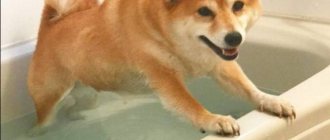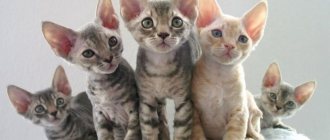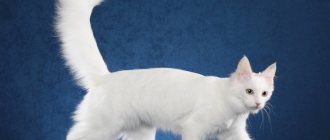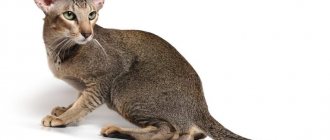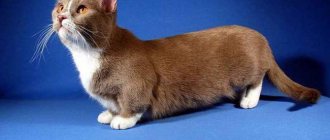Photos with the caption “Georgian cat” are increasingly appearing on the Internet. Indeed, the animal has a spectacular oriental appearance: large ears, a long nose and expressive eyes. In fact, this cat breed has a completely different name and, in addition to its similarity with Georgians, has a lot of remarkable characteristics.
History of the Oriental cat breed
Oriental cat
Genetically, oriental cats are close to the Siamese, with whom they began to be exported from Thailand in the 19th century. British breeders did not consider (or did not want to consider) green-eyed cats as an independent breed, so they classified them as a classic Siamese with a modified type of color. It is worth noting that at European exhibitions Orientals were not particularly favored, systematically disqualifying mustachioed emigrants either for non-standard colors or for the emerald shade of the iris.
The animals also did not arouse much interest among potential owners, so until the beginning of the 20th century, Oriental cats were bred only by enthusiasts who were passionate about breeding activities. The real crisis fell on the Thai Eared Cat in 1923, after the American Siamese Cat Club strictly tabooed the breeding of any variety of pets, with the exception of blue-eyed individuals with the Himalayan color.
For almost 30-odd years, Orientals were in limbo: they were expelled from the Siamese clan, but were never recognized as an independent breed. They remembered the cat only in the 60s by British and American breeders, who were carried away by the extreme appearance of animals. Initially, breeders planned to develop another variety of Siamese cat, which would have a uniform coat color, but would not lose the grace of its lines. To achieve this goal, Orientals began to be crossed with Abyssinians and other short-haired breeds.
1977 was a landmark year for Orientals, in which the wards of American breeders received their own standard of appearance. By the way, the first set of breed characteristics developed for overseas murkis was almost completely copied from the Siamese standard (with the exception of the points “body” and “colors”). But in Britain they were in no hurry to honor Asian cat breeds and spent 20 long years looking closely at them, scrupulously weighing the pros and cons. As a result, English long-eared cats were able to become an independent breed only in 1997, after official recognition by the GCCF.
Oriental cat with cat
Black oriental cat
Origin story
The origin of the Oriental cat has a branched family tree. The first mentions of the breed were seen in manuscripts. For a long time, Thailand was considered the homeland of the Georgian cat. Then England became interested in these representatives of felines, and in 1974 it was officially registered.
Oriental cats are sociable, feel attracted to people and get along well with them. The pet will be loyal and become not just a companion, but a true friend for the owner. Cats get along well with other animals. But they can also show leadership by defending territory. In this case, there is no need to worry. Aggression will be shown only in exceptional cases. Georgians have well-developed intuition. They understand the owner’s mood and try their best to adapt to it. With such a pet you will achieve mutual understanding. He will understand you like no one else.
Oriental cat loves to talk out loud and out loud
This is a very active animal that is quiet - it will not sleep peacefully next to you all the time. The cat will begin to look for adventures, playing with everything that comes under his paws. Georgians can show their temperament and perseverance. Therefore, you need to be prepared for the manifestation of this side of character.
Owners of Oriental cats describe them as affectionate and intelligent pets. Some of them are quite noisy. This is caused by a playful and active nature. Many people compare Georgian cats to dogs.
They are just as loyal and constantly demonstrate their sincere love with constant attention. Orientals - love for life. Full of affection, kindness and care
Full of affection, kindness and care.
Pros and cons of the breed
A cat that looks like a Georgian has many advantages. However, it also has some disadvantages:
| pros | Minuses |
| Beautiful appearance | Vulnerable character |
| High intelligence | Difficulty tolerating separation from owner |
| Tenderness, exceptional devotion | High cost - about 25–30 thousand rubles |
| Easy to care for | Talkativeness |
| Good health | |
| Pickiness in food |
Georgian cats are becoming increasingly popular all over the world. Today, the Oriental breed is already among the top 10 most popular. These animals are valued for their intelligence, ability to show love and tenderness, and also for their unique appearance. Those who dream of a devoted pet should definitely consider such a cat as an option.
Appearance of Oriental cats
The Georgian cat has a long body. Graceful lines create the image of an aristocratic animal. The tail is long. The head is large, triangular in shape. There is no smooth transition from the forehead to the nose. The cat's profile is even. The eyes are large, close-set, almond-shaped. Eye color is related to coat color.
Attention! Strabismus is considered a pathology of this breed. Big nose
There is no depression on the bridge of the nose. The kitten may have a slight indentation, but it will disappear over time
The nose is big. There is no depression on the bridge of the nose. The kitten may have a slight indentation, but it will disappear over time.
The ears occupy a sufficient area at the base, are large and widely spaced.
The length of the Oriental's limbs is above average. The bones are thin but strong. Oval shaped paws.
The coat is quite short, silky, and not prone to shedding.
Where did the Orientals come from?
How to care for the skin of hairless cats
The main condition for caring for a cat is control. The skin is very delicate and the sun can burn the animal. The owner needs to ensure that the kitty does not overuse sunbathing.
In addition, it is recommended to bathe your Sphynx weekly. To prevent bathing from causing aggression, you will need to get used to it from childhood.
Important! Once every two days you need to wipe your pet with baby wipes.
Comedo clusters may form on the ridge and near the tail. They cannot be squeezed out. This can cause inflammation on the animal's skin. To reduce the incidence of comedones, you need careful care of your cat's skin.
Thus, Oriental cats are popular pets. They are often called Georgian cats because of their unique appearance. However, they have nothing in common with this nationality.
In the article I will describe in detail the history of the origin of the Georgian cat breed. I'll tell you about a breed of cats similar to Oriental ones. I will pay special attention to the appearance of animals, their habits, manners and character. I will explain why Georgian cats are so interesting to society.
History of the breed
Oriental cats were first mentioned in ancient manuscripts of Thailand. Scientists have discovered images and descriptions of fully colored shorthaired cats. At the same time as Siamese cats, these animals were brought to Europe in the 19th century. In 1896, an exhibition was held in England where the blue oriental cat from Bangkok was presented for the first time. However, Siamese cats, which aroused great interest with their color, eclipsed their relatives for some time. Only in the 60s did breeders again show interest in solid-colored oriental cats. To create the breed, Siamese cats were crossed with fully colored shorthairs.
The Oriental cat breed was officially recognized in the early 70s of the 20th century; in 1974, the standard was finally edited in England. In the USA, a preliminary standard was adopted back in 1958. In 1974, animals of a new breed began to be registered; by the time Oriental cats were officially recognized, there were about 60 nurseries. Representatives of this breed came to Russia quite late, in 1987, but with their unusual appearance and devoted character they won the hearts of people.
Today, Siamese and Oriental cats are part of a single breed group and have a common standard. Orientals were originally called “solid chocolate Siamese.” In 1971, a variety of cats was developed that became known as Havanese. This nickname was due to the fact that the coat color of the species was very similar to the color of Havanese cigars; such cats have a lighter and more elegant physique and a different eye shape. The ebony variety of oriental color is also very beautiful - the coat of such cats has a rich black color, even the paw pads are black. In 1965, white Orientals were registered in the USA; their coat must be snow-white, without the slightest sign of yellowness. In 1972, Lavender Orientals were bred with light gray coats with a slight pink tint. There are also blue, red, cream, and tortoiseshell cats.
Most of the color variations of Orientals are tabby patterns: mottled, marbled or brindle.
Permanent color is established only in the 2-3rd year of a cat’s life; it is very important that there are no white spots on the body
What is the difference between Orietal and Siamese cat breeds?
Orientals are often called rainbow cats: there are more than 300 variations of coat color. The Oriental breed has virtually no genetic diseases
What is the difference between Orietals and Siamese: Oriental and Siamese cat breeds are the same thing. These breeds have an absolutely identical description in the standards of the whole world and differ (depending on the felinological system) only in color. Most European systems distinguish the Siamese breed from the Oriental breed by the presence of a point color (or, more understandably, by the animal’s light, uncolored body and blue eye color). Oriental cats have a fully colored body and green eyes. There are no other differences, and the character is no exception; it is also very similar in these cats. Of course, we should not forget that each cat has its own unique character traits, just like a person, each cat is an individual.
In connection with what was written above, I will further use the name “Orientals” to mean both Siamese and Oriental cats. So, Oriental cats are very lively, active, curious, affectionate and sociable.
Orientals have a great need for human attention and communication with them. Oriental cats also love the company of tailed cats, regardless of whether it is a cat or a dog. However, they achieve the greatest harmony in relationships only with their own kind or with light-type cats that are similar in temperament.
Every minute while the owner is at home, they will entertain him with their agility, their elegant jumping, talking, playing with the mouse, or simply sharing a seat with him in front of the TV. Oriental cats really don’t like to be left alone, so they are ready to circle around a person most of the time
The greatest happiness for an Orika (as we affectionately call this breed) is play with the participation of the owner, no matter what you choose for the game, a teaser with feathers or a laser pointer, or maybe just decide to play hide and seek!
The owner of the oriental cannot sleep longer than the alarm clock, you will certainly be reproached for this, because the moment has come when you need to communicate, and you are still sleeping. And if you stay up late at the computer, your pet will definitely remind you of the routine and invite you to sleep. The talkativeness of this breed is, of course, a subject for another discussion. Owners know absolutely exactly what their pet is communicating. Orientals use a very large number of sounds and intonations in communication, and therefore, communication with them turns into a real dialogue.
The most striking feature of Oriks is their ability to greet their owner from work. It’s as if from the very moment you closed the door behind you, leaving for work in the morning, he, unhappy, sits there and has already looked through all his eyes, waiting for his beloved owner! He will definitely express his opinion that working for so long is harmful (for the Oriental’s psyche), and then he will check all the packages that you brought from the store in order to find out if there is anything for him.
Another inseparable trait from an oric is curiosity. Often it is so large that even the most cowardly Orik will crawl out of the lair to see what is going on “there”. By the way, this is why in their upbringing we often have to remind them that this cannot be done even today. And check the order in your closets, oh, that is, in his closets, of course! Open the door or drawer of the cabinet, in which perhaps something interesting, or maybe even tasty, is hidden... yes, an Orientalist definitely needs this!
Curiosity does not leave the orik even when guests come to the house. Not only does it not leave, it grows in them with every new guest! They select keys for each new person. The most striking feature of orics is the ability to make people who do not like cats at all and do not understand them fall in love with them.
Another important characteristic feature of Oriental cats is the ability to have several coordinate points in an apartment at once. It seems like he was just walking along with his tail and was so carried away by this, when suddenly a rumble comes from another room, and you turn around - he’s sitting here and washing himself! Imagine how problematic it is when there are several of them of the same color!
Oriental company is a great joy. With Orientals it is never boring to do troublesome household chores, because you don’t have to do anything alone. Truly, you are flying home, because he is bored and completely lonely there. This is exactly how you start to get excited about oriental cats and acquire a second oric for your company, sometimes then a third, and a fourth, etc.
Appearance of an oriental cat
Orientals are typical Asians: graceful, lean, with the hypnotic power of a jade gaze. A distinctive feature of these charismatic pussies is their phenomenal plasticity of movements, thanks to which even ordinary stretching in their performance turns into a full-fledged yoga master class. Based on their coat type, Oriental cats are divided into short-haired and long-haired. The latter variety was born in the 60s of the last century as a result of crossing a shorthaired Oriental with a Balinese (Balinese cat). The Oriental Longhair was introduced as an independent breed in 1977, but it was only able to confirm its worth at exhibition competitions in 1997.
Head
Oriental kitten
According to the standard approved by the WCF (World Cat Federation), the head of an Oriental must have a flat forehead and a prominent profile. The muzzle of representatives of this breed should be narrow, and the chin line should be clearly defined. A mandatory item is the wedge-shaped shape of the skull.
Eyes
Almond-shaped, slightly slanting. The distance between the eyes is visually equal to the length of one of them. Regardless of coat color, all Orientals have rich emerald eyes. An exception to the general rule are white-haired individuals, whose iris color may be blue. Some cats have heterochromia (different eyes).
Ears
Quite massive in relation to the head. The ear flap is thin and wide, continuing the wedge-shaped line of the cat's muzzle. The tip is slightly rounded. The most intensive growth of the ears is observed in the first months of the animal’s life, which is why the Oriental kitten resembles a hybrid of Cheburashka and Yoda from Star Wars.
Graceful, elongated type.
Oriental cat face
Torso
Slender, noticeably elongated in length, with a well-developed muscle corset. The constitution of the body is close to lean: the animals look elegant and graceful.
Oriental longhair cat
Oriental cats have extremely long limbs, giving their silhouette a slight aristocracy and grace. The animals' paws are oval and relatively small.
Wool
Oriental cats have virtually no undercoat, allowing the fur to softly outline the contours of the body. The hair of short-haired individuals is shiny, satin-type. Long-haired animals have thin, silky hair. Since representatives of the second type have hair that fits tightly to the body, its real length is partially “lost.”
Color
Curled up into a ball
What the breeding experts were most loyal to were the color options for Orientals. Today, this is one of the few cat breeds that has the right to almost any shade of all existing ones.
In order to systematize the “colors” of eared cats, their basic types were identified by felinological associations. In particular, modern Oriental cats can have coats of such colors as:
- lilac (lavender);
- blue;
- red;
- Havana (brown);
- cinnamon (cinnamon);
- faun (beige);
- ebony (black);
- cream;
- white.
The preferred tabby colors are merle, brindle, ticked and spotted.
Defects and disqualifying defects of the breed
Serious defects that spoil the aristocratic appearance of Oriental cats include strabismus, any shade of the iris except green, as well as protruding and clearly palpable cartilage in the sternum area. As for exhibition events, first of all polydacts, very small or too thin individuals and cats with kinked tails will not be allowed to attend. The list of defective pets includes animals with insufficiently strong hind legs, spots on the fur in the form of medallions, as well as cats that breathe through their mouth. In the long-haired variety of Orientals, a double coat with a well-developed undercoat may be a reason for disqualification.
Possible rock defects
Judges will not allow oriental cats to participate in championships and exhibitions if they have the following defects in appearance:
- - kinks on the tail,
- - extra toes,
- - the iris is not green (this does not apply to white cats),
- - signs of cryptorchidism,
- - presence of undercoat,
- - color not meeting the standard,
- - ears are not big enough
- - too slanted eyes
- - poorly developed muscle corset,
- - body fullness,
- — white medallions are visible on the wool.
Caring for Oriental cats with a nose like a Georgian
What to feed
When choosing a brand of dry food, give preference to “super premium” lines; they will replenish the balance of essential vitamins and microelements, making the diet balanced and the pet’s appearance well-groomed. Read more about feeding.
It is recommended to give preference to feed from the following manufacturers:
- Royal Canin labeled healthy food,
- Hills for active breed cats.
Rules when creating a menu for a pet:
- for coat care, it is recommended to give Orientals 2 drops of melted butter as an additive to their main food;
- foods high in fiber should be excluded;
- the presence of fats in food is necessary (about 20% of the total diet), the amount of carbohydrates can be reduced (2-3%), proteins make up up to 50%;
- from meat you need to give beef, chicken, turkey, rabbit from a trusted supplier and of high quality;
- boiled sea fish, strictly without bones, 1-2 times every 7-10 days;
- exclude dairy products from the menu of an adult cat, this leads to diarrhea.
You should always make sure there is fresh water in your cat's bowl!
The Oriental's feeding schedule depends on its age:
- Kittens are fed 5-6 times a day;
- Growing individuals should be given food 3-4 times (9-12 months);
- adult cats are fed more often 2-3 times depending on the amount of food and menu items.
How to care for claws, eyes and other body parts
The Georgian cat, in accordance with the standard, has short hair, without undercoat, which does not require special care, you just need to maintain a balanced diet, do not give the cat harmful foods or cheap dry food.
It is not recommended to bathe Orientals:
- firstly, they take excellent care of their fur;
- secondly, they do not like water treatments; contact with water can be stressful for the pet.
To care for your claws, you need to take the following measures:
- be sure to purchase a scratching post and teach your Oriental to use it from a young age, otherwise overgrown claws will become a problem not only for the cat, but also for yours;
- If the claws continue to grow, you should carefully cut off the long part of the claw in the place where there are no blood vessels using special scissors.
The outside of the ear must be systematically inspected and cleaned with soft cotton wool ear sticks. The procedure is carried out once every 10-14 days.
If you notice dark-colored discharge, contact your veterinarian immediately!
Representatives of the breed are very sensitive and prone to gum inflammation, so caring for the cat’s mouth should be carried out regularly from a young age. To do this, teeth are brushed 2 times a week using a children's toothbrush and a special paste.
If inflammatory processes occur on the gums, you should immediately contact your veterinarian!
Bowls should be kept in exemplary cleanliness, do not forget to wash them as often as possible.
At what age should vaccinations be given?
Vaccination of Orientals and Siamese cats is carried out according to the same schedule:
- 9 weeks;
- 12 weeks;
- 15 weeks;
- 6 months;
- 12 months.
Before vaccination, it is necessary to examine the general condition of the animal, undergo a preparation procedure, including timely distribution of anti-worm medications (carried out in accordance with the veterinarian’s recommendation 7-14 days in advance).
Every year, Oriental cats must receive the following vaccinations against:
- panleukopenia;
- calicivirus;
- rhinotracheitis;
- leukemia virus;
- rabies.
What pet diseases can an owner encounter?
The average lifespan of a cat similar to a Georgian is from 12 to 15-16 years
The cat’s health depends on quality care, because many diseases can be prevented at an early stage if you pay due attention to your pet
The Oriental cat has fairly good health, but is prone to inflammation of the gums, the tissues that surround the teeth.
Prevention of gingivitis and periodontitis is mandatory; for this you should follow hygiene procedures and regularly visit a veterinarian who examines the animal!
Often representatives of the breed have common diseases with Siamese cats: heart problems, kidney disease, manifestations of liver failure.
Remember, an annual examination by a veterinarian is mandatory for cats 7 years of age and older!
Life expectancy and health
Georgian cats live on average 15–16 years, and some individuals live 18–20 years. Although they have good health, animals are still prone to some hereditary diseases:
- cardiomyopathy;
- liver amyloidosis;
- retinal atrophy;
- flat chest syndrome.
Oriental cat care
Even with all its exotic appearance, the Oriental cat is not demanding in care. Their unpretentiousness is another reason why the animal has won such love from fans. Even scratching should not be too frequent. You can keep your coat looking beautifully shiny simply by regularly using a rubber glove. Grooming involves examining the ears, eyes and claws.
How to properly care for your ears and eyes
Eyes should be wiped clean of discharge every day. To do this, you can use a cotton pad or soft cloth. It is recommended to carry out the procedure using tea leaves or warm water. Oriental ears do not require special care. Delicate and sensitive skin should be cleaned with cotton swabs soaked in Vaseline, vegetable or special oil. During the procedure you need to be very careful, not to make unnecessary movements or sudden pressure.
Features of hair care
Short-haired representatives are very easy to care for. You need to comb them at least once a week, changing brushes to remove dead hair. The frequency of brushing for long-haired Orietals should be greater so that the hair does not get tangled. There is no need to wash your pet often. In winter you need to bathe as little as possible, and in summer - when dirty, but not more than once a month.
Preventative nail care
At least once a month it is necessary to trim the animal's claws. You need to do this so as not to injure your paws. You cannot cut off more than 2 mm of the length of the claw. For the procedure, it is recommended to use special nippers or sharp scissors. In order for the animal to get used to this procedure, it is worth starting to carry it out regularly from an early age. The best option is to trim one nail every week.
Keeping an Oriental cat
The character of Oriental cats, both small and adult, is particularly energetic, so they need a place not only to relax, but also to play. A ball, mice, fishing rods with bows - this is only part of what such pets might like. Today you can find a variety of devices that will not let your pet get bored and will protect things from the claws of a playful animal.
Place to relax and play
A pet definitely needs its own place, and it should not just be a soft bed. An animal with a playful nature requires various scratching post structures, houses and other play elements. It is recommended to choose these devices immediately in large sizes, so that as they grow older they do not become too small for the cat. The main criteria are convenience and durable material, and it doesn’t matter whether the house is open or closed.
Scratching post and toilet
The choice of scratching posts is very large - free-standing, with a play area or a house, for mounting on the wall. If you want to prevent your cat from damaging your furniture, you should definitely purchase at least one of the listed ones. It is recommended to use a closed toilet so that the animal cannot throw the litter around. Orientals are very smart, so you can try to teach them to relieve themselves even on the toilet. To do this, place the tray next to it, and then gradually increase the level at which the toilet stands. It is then moved onto the seat and then removed completely.
Sphynx cats: reviews from owners
Reviews from owners say that sphinxes are incredibly cute. If the future owner dreams of love at first sight, or rather at the first touch, then this velvet animal is just the thing.
Cats are very playful and affectionate. They are very attached to the owner and to everyone in the house. They show their feelings very clearly. They love to purr and sing loudly. They are very afraid to be left alone, so breeders recommend spending as much time as possible with the cat. It is important for a pet to have its owner nearby.
One of the disadvantages that all owners talk about is the toilet. After the cat has done its business, hygiene procedures will need to be performed. Sphinxes do not really like to lick themselves, which is a plus on the one hand, and a minus on the other. Plus, they don’t put anything dirty in their mouths. The downside is that the owner will have to be a cat mother and constantly care for the pet.
Important! One strange feature of these cats is their lack of satiety. Eating is their middle name. They love fruit very much.
Due to the lack of wool, they freeze. The owners advise equipping a house or a warm bed for the sphinx. This method of creating comfort for a cat will protect it from hypothermia and illness. If they are cold, they will not be silent. The cat will meow loudly and come running to warm itself.
Sphynx is a hypoallergenic breed
Character of an oriental cat
Oriental cats are sociable, feel attracted to people and get along well with them. The pet will be loyal and become not just a companion, but a true friend for the owner. Cats get along well with other animals. But they can also show leadership by defending territory. In this case, there is no need to worry. Aggression will be shown only in exceptional cases. Georgians have well-developed intuition. They understand the owner’s mood and try their best to adapt to it. With such a pet you will achieve mutual understanding. He will understand you like no one else.
This is a very active animal that is quiet - it will not sleep peacefully next to you all the time. The cat will begin to look for adventures, playing with everything that comes under his paws. Georgians can show their temperament and perseverance. Therefore, you need to be prepared for the manifestation of this side of character.
Features of behavior
The Georgian cat breed gets along well with people and other pets. They have the gift of subtly sensing the mood of the owner; cats are not aggressive, but if necessary they are able to stand up for themselves.
It is worth noting that hyperactivity is often found in representatives of the species, then any object in the house, including curtains, furniture, and decorative elements, can become a cat’s toy. You need to be prepared for this: prepare yourself mentally, arrange a spacious play area with various exercise equipment for your pet. Read here how to train your cat to behave well .
History of the origin of oriental cats
The historical homeland of this amazing cat is Thailand. The first mention of the mysterious cat dates back to the 13th century AD. They were mentioned in a “collection of poems about cats.” For several centuries, the country's authorities at the legislative level prohibited the export of such exotic animals from the country. In this regard, in other countries no one knew anything about them and had never seen them.
Oriental cats first came to the New World only in the 19th century. In London, a cat and a cat of this breed took part in an exhibition that took place in 1894. However, these cats were disqualified. The description that the exhibition staff compiled about the amazing, unknown animals is still preserved: “representatives of the Siamese breed with a chestnut color and a green iris.” Cats of this breed were considered Siamese and were excluded from participation due to non-compliance with the standard.
A similar situation occurred two and a half years later in England. The organizers of the exhibition excluded the cats from participation due to identical coat color to Siamese cats.
To obtain the necessary colors, breeders crossed representatives of Siamese cats with representatives of many other breeds - Russian Blue, Abyssinian. It is noteworthy that ordinary outbred black cats were also used for selection. After the appearance of new flowers, interest in cats began to grow. In 1977, oriental cats were officially registered.
What is the name of a breed of cat that looks like a Georgian?
Cats with an elongated muzzle and a straight profile are called Oriental. This is an ancient Thai breed. Representatives of the breed are connected with Georgia only by a playful comparison with the proud, big-nosed men of this magnificent country.
The Oriental cat has a unique appearance, which due to its specific features is not liked by everyone. Oriental pets are owned either by those who like the funny and ridiculous appearance of the breed, or by those who are crazy about the affectionate, sociable, lively nature of the animal.
Orientals are cats of the eastern type with a long sinewy body, graceful movements, elongated limbs, and a narrow muzzle. The Georgian cat is an ideal pet for a large and friendly family that spends a lot of time at home.
Breed care
Oriental cats are very smart animals, but raising them correctly is very important. The “carrot and stick” method applies here, but the requirements must be strictly followed
If the owner has forbidden something, then you should not allow it to be done next time - the cat may think that it is being deliberately bullied and will begin to do whatever it wants. It is strictly forbidden to beat an animal; this can damage the pet’s psyche and turn into an enemy. Orientals have a very keen sense of a person’s intonation, so a strict and demanding tone will be enough.
If everything is left to chance, they can climb the curtains, destroy everything and even go to the toilet in flower pots. Therefore, it is necessary to start education from a very early age.
Finding a replacement for such wild games is easy - they will be happy playing with ordinary crumpled paper, especially if at this moment the attention of the audience is drawn to them
Oriental Shorthair cats require minimal grooming, as their hair is very short and the undercoat is not particularly noticeable. Wiping the animal's fur with a damp glove will be sufficient. It is advisable to bathe them as rarely as possible: cats have an extremely negative attitude towards water. The Oriental Longhair cat requires a little more care. Since the medium-length coat is not prone to tangling, it is enough to brush your pet once a week.
Oriental cats have rather long claws, so the owner will have to trim them from time to time. But this must be done carefully so as not to affect the line of blood vessels. It is better to carry out the procedure using a nail clipper.
Oriental cats have a developed instinct for procreation, so if breeding is not planned, it is better to castrate the animal at an early age.
Pets do not tolerate cold weather and wind very well: their fur can darken, and the animals themselves can catch a cold. Therefore, it is better to leave them at home during frosts.
Oriental cats have a very picky character, including when it comes to food. But they should not be overfed in order to maintain a slim and flexible body. Pets should be fed twice a day in small portions. The animal's menu should include fresh meat and raw ocean fish. Pork and fatty fish are prohibited to avoid liver problems.
A loyal and talkative Oriental cat with his wonderful songs and fairy tales can become an indispensable companion to his owner.
Training and education
Among all cat breeds, Orientals are distinguished by their special intelligence and devotion to their owners (not every dog is so loyal)
If you have the desire, then you can easily teach your Georgian cat to do various tricks, for example, fetch a ball, stand on his hind legs, give a paw, or jump through a hoop.
The most important thing is that when you train your handsome little boy, do not punish him or treat him rudely, but, on the contrary, encourage your mustachioed “student” with your favorite treats. The most important thing is to be patient while practicing.
What is especially pleasant for the owners of Orientals to know is that this breed is perfectly accustomed to the tray, as well as to the scratching post. Georgian cats are unusually clean - they will never go to the toilet in different places in the home. They relieve themselves strictly in a tray or dry closet.
Breeding
Breeding Orientals requires experience. Finding a cat to breed is only half the battle. It is not a fact that the kittens will turn out “exactly” like the selected father. There are many nuances that experienced breeders know about.
Estrus in an Oriental cat is no different from other breeds. It is recommended to breed a breeding cat at least once a year and no more than once every six months. If a cat, in the presence of small kittens, asks for a cat again, then it is better to follow the pet’s lead and get her together again. The mating process must be approached very responsibly, taking into account the right time and the right partner. If show class kittens are needed, then both parents must also be of the same level. However, there is no guarantee that the entire litter will correspond to a given class. Only experienced breeders can determine the future fate of the litter - who is suitable for breeding or who “goes” to the so-called pet class (not suitable for breeding and participation in exhibitions). A cat's pregnancy lasts from 58 to 70 days. No special care is required for the animal, the only thing is that you will have to revise the nutritional standards by increasing the volume. You need to feed special food for pregnant and lactating cats. The belly begins to grow at 4 weeks, and already at 6–7 weeks you can feel the kittens moving. When the eighth week approaches, it is necessary to prepare the cat's place for birth. This should be a secluded, calm place. Childbirth in Orientals is not much different from others - she can lie quietly or run around the apartment, meowing. Labor can last from 2 to 6 hours. Kittens are usually surrendered at the age of three months
When choosing a small oriental, you should pay attention to its appearance. The kitten should look healthy and nimble. Eyes and ears should be clean, free of discharge, fur should shine in the sun.
When purchasing, the owner must present a birth certificate or pedigree. If there are no documents, then most likely the kitten is a mixed breed. If an animal is purchased for breeding, it is best to take it from a nursery. These are breed-class cats with good pedigrees. Animals are castrated between the ages of 8 and 12 months.
The eyes and ears should be clean, without discharge, the fur should shine in the sun. When purchasing, the owner must present a birth certificate or pedigree. If there are no documents, then most likely the kitten is a mixed breed. If an animal is purchased for breeding, it is best to take it from a nursery. These are breed-class cats with good pedigrees. The animal is castrated at the age of 8 to 12 months.
masterok
And indeed, from the outside it looks like a child’s drawing of a child who was trying to draw a cat. We’ve discussed so many options for cats here on the blog, but I still don’t know who these long-eared cats are. Some call them “Georgian” cats, others jokingly call them “elven” or “a cross between Dobby and a cat.” What kind of breed is this actually? Photo 2. The history of the origin of the Oriental breed began with their closest relatives - Siamese cats. True, both breeds have changed over time, so now their representatives are no longer as similar to each other as they were before. For example, on the face of Oriental cats there is never a black mask characteristic of Siamese, and their character is much softer. Photo 3. The ancestors of both of these breeds were first brought to England from Asia at the end of the 19th century, then the history of Oriental cats began, although their first images have been found in ancient Thai manuscripts. In 1896, for the first time, an exhibition was held, which included an oriental blue cat brought from Bangkok. True, after this a “boom” for Siamese cats began, and their relatives with a solid coat color were somewhat forgotten until the mid-20th century. In the 60s, British breeders began to breed a breed similar to the Siamese, but with a different coat color, and this is how the history of the Oriental cat breed as we know it began. Photo 4. The breed received its official confirmation a few years later, not only in England , but also in America (officially recognized in 1977). At first they were completely white cats, then with the Havana color, and then with the rest. But at the time of recognition, there were already more than 50 nurseries of these cats, and they were actively bred and purchased, despite the fact that there was no official confirmation. They first appeared in Russia in 1989, and immediately gained love and popularity among our compatriots, along with the Siamese. Since the origin of the Oriental cat is closely related to the Siamese, now they are classified as one group of breeds, have the same standards, and they can even be bred together. Photo 5. Cats of this breed are slender, muscular, with a long graceful neck, narrow hips and shoulders. The front legs are proportionally shorter than the hind legs, the paws are oval, small in size, and the belly is tucked. The tail is thin, pointed at the tip, very long. Photo 6. Psychology An oriental cat is very smart. If you have earned her respect and love, you will never feel betrayed by a cat.
The Oriental is very attached to a person, so she is offended if the owner, instead of petting, playing or just talking, is busy with his own business. Representatives of the Oriental breed, like all cats, are sure that the world was created for them, and therefore they will meow, trying to attract attention. Although their voice is quite pleasant and melodic, unlike Devon Rex or Ragdoll dogs. This is not a breed that will walk on its own, it needs a friend and playmate
This is not a breed that will walk on its own; it needs a friend and playmate.
Therefore, it is worth getting one for those who have more freedom with their time, like to play and don’t mind a “heart-to-heart conversation” - the cat loves to talk out loud and out loud. Those who love peace and quiet should consider another furry friend with a calm and quiet personality. Calm breeds include exotics, Persians, Abyssinian and Russian blue cats, as well as Scottish Straights and representatives of the Maine Coon breed. Photo 7. The Oriental cat seems to have telepathic abilities and easily senses the pain, desires and mood of the owner. Surprisingly, she can be taught some tricks, such as walking on a leash or fetching a ball. However, make no mistake, a cat will perform tricks if it wants to, and not under coercion. It is easier than representatives of other breeds to teach Orientals to go not even to the litter box, but, excuse me, to the toilet, to open the tap in the bathroom or kitchen so that drink water. In addition, they are also energy therapists - they lie down on a sore spot, curl up in your arms if you are tired. They get along well with children and do not forget, releasing their claws and fangs, even in the midst of games. Orientals react very friendly to the arrival of guests, charming and touching them. As for other pets, animals can make friends with them too. Photo 8. Photo 9. Photo 10. Photo 11. Photo 12. Photo 13. Photo 14. Photo 15. Photo 16. Photo 17. Photo 18. Photo 19. Photo 20. But this cat reminded me of this actor from “Star Wars” Photo 21. Or, for example, this fox: sources
TOP 1 cat that looks like a Georgian
For a long time now, various photographs of cats that are very similar to Georgians have been circulating on the Internet: they have an elongated nose, huge ears, a non-standard skull shape and slanted eyes. It is because of these striking external characteristics that fans of four-legged furry cats often compare these cats to Georgians. By the way, these breeds have nothing in common with Georgia - their homeland is Thailand.
Perhaps the resemblance to cargo in cats is a recessive gene. But there are several other facts indicating the relationship of these breeds. Thus, so-called “horned” genes are very common in Georgian cats. In addition, over the years they have been able to change a lot - for us they are classic cats with huge ears and a cunning look.
Whether or not to believe that cats are like Georgians is up to everyone to decide for themselves. So, let's look together and figure out what's what.
Representatives of this breed are sweet, charming and touching. It can be both domestic and quite outdoor, especially during the rutting period.
Cats of this breed are very popular in China, where the breed is called "Coco Inu". This is not an ordinary cat with an unusual color, but at the same time it is incredibly affectionate, amenable to training and loves to sleep.
At the moment, representatives of this breed are not registered in Russia, but perhaps they are already on some foreign website.
The longhaired Angora cat is one of the most popular and popular breeds known to man. She is unusual not only for her unusual coat, which can be plush or silk, but also for her curious character.
The Angora cat has very soft, thick fur. It has no undercoat and thanks to this the cats look very unusual. Angora kittens can be fluffy, or they can be completely short-haired. Their weight is no more than 3 kilograms.
Some people believe that Angora cats are only suitable for very loving owners. But not everyone thinks so, because they have a lot of advantages that make them very beloved pets.
The basis for this breed is the Turkish Van. Representatives of this cat are very affectionate and gentle, they cannot stand loneliness, but quickly become active if they play. Their character is very nervous, so be prepared for the fact that they may start screaming for various reasons. Otherwise, they are very affectionate and gentle cats.
The animals inherited this “Georgian” resemblance from their ancestors - the fold-eared Siamese. So, who exactly is the Thai Shorthair cat breed?
The Bichon Frize is a playful, active, very domestic cat with strong hunting instincts. This breed has sad eyes, but this does not stop them from being the most loyal animals in the house. In the natural environment, they behave very friendly and are not afraid of noisy neighbors, so they are often found in hostels, hotels, and business centers.
Thai fold cat. They are called the “Kings of Kitties,” and for good reason. These are one of the most beautiful representatives of the breed. Their face is very funny, with large fluffy ears. Cats of this breed have an independent character and also like not to be bullied. It is believed that these cats are very sociable, easy to train, but do not like to be alone. They very quickly get used to the house and other people, so it is very important for them to have their relatives in the house.
Tahitian, a fold-eared cat breed. These cats are distinguished not only by their excellent character, but also by their extraordinary appearance. They are one of the rarest breeds in the world. Tourists hardly notice them; they practically never leave the room.
This breed is the result of crossing a Thai cat and cats that lived in Thailand. This unusual cat is very friendly and easy to train, but she is also very critical. She loves precision and neatness. Even the smallest cat of this breed is very difficult to tame.
This is a tall-legged cat breed. Its body is elongated, its head is long, its ears are large, its muzzle is round. It weighs up to 15 kilograms. Her eyes are large and widely spaced. According to the standard, this breed should be considered long-haired, but in fact, this is not entirely true. However, keeping such cats requires special attention.
Today, a photo exhibition dedicated to the monkey itself opened at the British Museum (UK).
Representatives of the British army decided that what they loved more than anything in the world was drinking coffee.
Not long ago, unusual behavior of monkeys was noticed in one of the Sydney zoos.
As you know, all monkeys in the world, when in danger, begin to emit signals, which can be chirping, meowing, and even roaring. But one of the largest and most restless animals in the world, the African elephant, turns into a real fighting unit during the mating season.
The breed reached its peak in popularity in 2005, when all media, including the world's, were full of reports about the appearance of cats with Georgian ears. However, then the meme began to fade and the popularity of this breed gradually faded away.
Now grooming of these cats remains quite rare, since it is no longer fashionable to color them. However, cat lovers still continue to be interested in their appearance and often imagine exactly this appearance of their pets.
With this in mind, the Georgian Style Cat Grooming Foundation was created in the United States in 2011. Now artist-groomers from the USA, Great Britain and other countries are searching for and breeding new breeds of dogs with pear-shaped heads and elongated ears.
The ancestors of this breed are Siamese cats. According to the documents, these are the only cats in the world that are blue in color. And in 1943, the Georgian Basenji breed was officially registered.
In addition, these kittens boast very long hair, which is their distinguishing feature and is admired all over the world. By the way, the color of these pets can vary from white to pink, depending on the preferences of the breeder.
What is the secret of the Georgian Basenji breed? The fact is that these cats have the habit of stretching out their front legs. And kittens of these breeds are born with a large number of folds on the skin. As the kitten grows, their fur thickens. In addition, these kittens have very long ears, which become noticeable not only to the people around them, but also to the owners of these pets themselves.
Siamese cat Siamese cats have dark, almost black eyes with a greenish tint. A distinctive feature of the animal's color is its brown undercoat with an admixture of black hair. Because of this, the woolly part of the body always remains unkempt.
The King of Thailand's Cat There is a legend about a Siamese cat, according to which the King of Thailand was secretly in love with his wife. Therefore, he constantly demanded special attention from his mistress and forced her to visit special women’s clubs. One day, the queen received from her husband a list of what she was supposed to give him for the holidays, as well as the amount that he wanted to transfer to her monthly for his maintenance. After going through all her things in her head, the queen finally settled on a Siamese cat and a kitten.
Pavana Every Friday the queen went into the city to one of the city's furnished apartments, where she lived and worked. There she usually gave instructions to her manager, who had to be present at this event. After each occasion, the queen received delightful gifts, including Siamese cats.
After three successful miscarriages, the queen, unable to tolerate this state of affairs any longer, after another visit to her husband, wrote a letter to the “royal club”, where she signed it as the owner of all nurseries that breed Siamese cats. She also attached photographs with a description of the breed to the letter. And what happened next?
And then there was a dark day for the queen, firstly, her cat died, and secondly, the breeding of Siamese was prohibited on the basis of a law passed by the King of Thailand, according to which the breeding of these unusual animals is prohibited, and their owners cannot obtain offspring from crossing with representatives of other breeds.
White Siamese The Siamese breed is more than two thousand years old. One of the official symbols of the capital of Thailand, Bangkok, was named after this cat.
In addition, in honor of the cat, His Majesty Sisanpongtong Rama IX, who was king from 1999-2002, was awarded the Order of Honor. ________________________________________
Oriental cat. The Oriental cat has a wet, reddish-brown coat with white spots.
The purple ocelot is a small, elegant creature with a triangular head, large head and large ears. This cat is currently a wild breed, but was once brought to America. Purple ocelots are bred as domestic cats and lack activity.
The Bolivian cat is one of the largest and most ancient native cat breeds. It has a rounded, low-set croup, a long and narrow muzzle, powerful paws with large hands and pointed claws. The Bolivian cat needs a spacious enclosure where it can turn around normally, and some exercise with toys.
The Bombay cat and the Siamese cat are twins, but, unlike the Siamese cat, the Bombay breed has much longer and fluffy ears and tail, and on the body, in addition to black, there are also white spots. The Bombay cat needs to be walked on a long leash, as it does not get along well with other cats. In Thailand, the Bombay domestic cat is popular as a pet, and in Japan it has long been considered a symbol of the country.
Pumas are ancient hunting cats with short and thick hair. The Puma is a compact, medium-sized dog with good reflexes, viable and adapted to life in the wild. Cougars are also called tattooed cats.
The African Shorthair cat is very short, large, with a rounded cone of the muzzle and large eyes. The cat has strong bones, large ears and eyes. On the head there are sharp contours of the pattern.
The camel cat is a small cat with short hair and a powerful, muscular body. The cat's fur is hard, thick, and black. It is often used as a folk craft item.
Today there are about 500 cat breeds in Russia, which is more than 150 years ago there were about 120. Moreover, some cat breeds over the past decades have differed significantly from their ancestors. Over time, they began to be crossed with each other to create new breed lines. Cats bred as a result of such crossing often inherit the characteristics of their great-grandparents.
By the age of 7-8 years, the cat should be ready for active exhibition activities. He should not be lethargic or nervous, aggressive or fearful. The desire to participate in exhibitions is very important for cats, as it presupposes the presence of motivation for intense activity. However, this does not mean that all age groups should work hard; Some activities, such as rat hunting, which they can do with ease, should not tire them out.
But exhibitions are a different matter. They must be carried out regularly and on a large scale. To convince a cat to participate in a show, you can't expect him to simply go to an adult cat. For a cat who is dissatisfied with his show success, participation in the show by an older family member or a showroom employee is appropriate. Show cats are often sensitive, nervous and shy. The nature of some show breeds also contributes to this.
If the cat is not active and choosing to participate in exhibitions is still an option, additional efforts can be made to smooth out any loose ends and prepare the cat for the exhibition experience. Anyone wishing to participate in the exhibition must ensure that the right decision is made in the family council. Of course, cats are cats that initially do not need exhibitions.
They pay a lot of attention to health and physical development, eat and sleep regularly - in short, they lead a lifestyle that involves the cat's participation in exhibitions and his predisposition to this.
Most often, a cat does not participate in exhibitions due to lack of desire. To satisfy this interest, you can use tips for preparing it.
For about 5 weeks before the show you should nurse and wag:
1) Try not to let your cat play with his toys dangerously close to his claws and the edge of the scratching post;
2) The cat can play and frolic at any time and anywhere;
3) Give the cat the opportunity to get used to the daily routine of the exhibition;
4) If this happens, stop working with the cat and wait until he calms down.
5) Cat shows are not a sport, so do not forget to put sufficient protection on the cat - preferably a collar.
6) Make sure in advance that the cat knows where to go.
It is not widely used in Russia because of its “refined” appearance. Not all cat breeds inherited from Siamese cats have an oriental appearance. However, every year the population of Oriental cats is growing steadily.
Orietta is a representative of the cat family with amazing colors. White, reddish-white or purple - you can meet it at every step. This is a very beautiful animal, so the demand for them is high. The cost of an Oriental cat is in the middle price segment. It is necessary to pay attention to the type of coat. Typically, these cats are classified as long-haired, but a few individuals have shorter hair. Oriettas are very sociable animals. They love to walk and participate in exhibitions.
Hairless white cats are genetically monogamous, at the same time they can fall in love with a mongrel kitten, but if the owners give an Oriental kitten, the kitten will be devoted to the owner, like a member of the family. Cats of this breed are very attached to their owners and can be dangerous to strangers.
Representatives of this breed have long been used in the royal family. In Portugal, the Oriental cat breed was represented by the fiefdom of the royal family - the Ashpool House. In this family, oriental cats were a decoration and a source of all kinds of well-being.
In addition to their incredible beauty, Orientals are distinguished by their health, high breed qualities, ability to absorb various odors, cheerful disposition, cleanliness, friendliness, gentle and affectionate character.
The International Cat Show took place at the Eurasia 2017 exhibition (September 22-24, 2022) in Yekaterinburg. As part of this event, the Nevskie Berega pet exhibition was held (October 21-24, 2022). At the exhibition one could see representatives of this rare breed of cats.
In our country, Orientals are not often exhibited at exhibitions, because they are much more expensive than ordinary mongrel cats. That is why kittens of the ORIENTAL BREEDING CAT breed are not cheap.
Our partner organization “Tibet”, in collaboration with nurseries, held the “Miniature Oriental” competition in 2016. The prize fund was 30 thousand rubles. Cats no older than two years old were accepted for the competition. All winners receive prizes from the nurseries they work with. We will hold such competitions in the future.
Oriental cats have several colors and are genetically homogeneous: mini, cats (all colors with a predominance of tan colors, white, blue, cream, red, black and white, etc.), marbled, Abyssinian (short-haired), short-haired, long-haired, unicycles , terriers, tricolor.
But, despite the fact that they all inherited the shape and color of their coat from their ancestors, this happens as a result of various mutations that prevent them from ultimately turning into the classic “Siamese cat.” Such mutations cannot be called random. For example, if interracial crossing has occurred (in which an animal (as well as a person) becomes heterozygous for an allele, that is, heterologous for both alleles in the parents) or mutations in the testes and ovaries, an animal that has become heterozomygous for one allele may be homozygous on the other. If the structure of the animal’s breed sense was different and the cat easily distinguished colors or clarity of shapes, then now it is heterospadoid.
The standard colors of Oriental cats include:
Small spotted cats have a very unusual coat color. It consists of three black and two white stripes running from nose to tail.
Grace and style, elegance and luxurious appearance, special grace and sophistication, courage and courage, all these qualities characterize Orientals. The Oriental cat has amazing affection and good manners, and also gets along well in any home, showing soft, unobtrusive resistance to strangers.
Caring for an Oriental cat is much easier than caring for other domestic cats. According to experts, caring for an orienal cat is almost the same as caring for any other purebred cat.
Before exhibitions and domestic competitions, the oriental cat is thoroughly combed and bathed in warm water with the addition of chamomile infusion and vegetable oil (without washing off the remaining shampoo and conditioner from the fur).
The color of the Oriental is a balance between dark and light coat colors.
The Maine Coon is a powerful, beautiful and confident cat.
Being direct descendants of Siamese cats, Maine Coons have become an integral part of modern culture. These cats have a unique charm, graceful body and excellent appearance. Maine Coon owners are always in the spotlight.
This breed includes Siamese kittens, Siberian kittens, an Oriental kitten - a descendant of an Oriental, and a Scottish Fold kitten - a representative of the breed.
So, briefly about the character of the Siamese cat, which can be easily recognized:
The Siamese cat is a sociable, affectionate, warm-hearted, friendly and cheerful animal, gentle and affectionate.
The Siamese themselves are very reserved and quiet, and this is especially evident during the mating season. Watching this incredibly beautiful and majestic ceremony is simply amazing!
The Siamese is difficult to confuse with anyone else. Kittens with blue eyes, long black silk fur and an unusually clear look.
The Siamese's favorite treat is a Maine Coon kitten curled up in the owner's arms.
With her strong and beautiful paws she loves to scratch and bite a soft toy.
When it comes to training, a Siamese cat is practically perfect. She has virtually no submissive instinct, which allows her to get along well with children and pets. Siamese cats are very clean and therefore you can often see a person cleaning up their pet's hair.
Cats of this breed need long walks, besides, they are easy to train, and with the right approach they become excellent friends of children.
The evolutionary process has long led to the formation of the type and species of cats that you see in the photo below:
The very first individuals of this breed were brought from Siam to France.
The descendants of the Siamese kitten resemble the Siamese cat in appearance. They have large sizes, fluffier fur, more graceful body shapes, all lines are drawn, and their eyes are large, almond-shaped, amber in color.
Despite their strength and beauty, cats of this breed are particularly modest and obedient.
Orients are a cat breed that is a descendant of Siamese cats. Descended from Egyptian cats that were brought to Europe in the early 20th century.
The color of the Oriental cat is black, lilac and blue.
Oryxes have a special love for water and can swim independently.
Here are some interesting facts about the life of these cats: 1. Oryxes have excellent hearing and can hear when they are petted. 2. Orientals do not like to use the litter box. But ordinary cats use the litter box well and often. 3. Oryx is a Siamese cat that has inherited the characteristic Siamese appearance. Orissas are surprisingly easy to train. 4. Oryex nurseries are extremely popular in Europe and Asia. 5.Orichs can be easily tamed and taught various tricks. 6.They love to swim. 7. An Oritan cat can live 5-7 years. 8. In the oryx, you can notice characteristic genetic abnormalities, which manifest themselves in the form of bald spots on the head and body. 9. Orins are especially popular among fans of the show in which Oryex producers participate. 10.Oriki can eat both meat and fish. Oriki feel good in their summer cottages and in the forest. 11.Look into the future of the oriental cat: 12.Oryix is the most beloved pet of the famous storyteller John Beaver. In the movie Lifeboat, the main character uses an Oryek toy to force a cat to cross a river. 13. In America, oriental cats are very popular as pets. 14.Next year they are going to create a new oriek nursery. 15. There are many people in the world who want to have an Oriental. 16.Under socialism, Orientals were bred only to produce a rare breed. Now, under socialism, you don’t have to get cats to get a breed; it’s enough just to have an Orika at home. 17. Oriented cats (orins) are like a surreal reflection of a person.
The breed's orientation is mixed, so the pet is constantly ready for battle and hunting, which is not carried out within the framework of quiet everyday life. Representatives of the breed easily learn new skills and will show obedience and devotion if the owner walks them well. But this will not be enough to cope with the intense competition from outdoor cats.
Toy poodle. This dog is so smart that one of its characters is the most popular in the world. The breed is considered universal, so it can be purchased for any companion and for any family. A representative of the breed does not need increased attention from the owner. He will live peacefully in any house or apartment.
Mei-kun. The May Coon breed is a clone of the East European Shepherd. This is one of the smartest dogs of our time, distinguished by its beautiful appearance and friendly character.
A representative of this breed does not have a distinct gender, so many lovers are not aware of its preferences. In addition, in a family, a baby can become a thunderstorm for parents, and approach the old lady with passion.
The breed can be purchased for both active and relaxing recreation. This dog will become a faithful assistant at home, as well as an excellent companion for outdoor walks and sports.
When choosing a new dog for yourself, it is important to take into account many factors: age, character, characteristics of caring for your pet, temperament, health. Small dogs are distinguished by intelligence and sophistication, while large breeds are distinguished by endurance and strength.
To understand whether it is worth getting a pet, you need to make sure that you are happy with everything in the house. Only then can you make an informed choice.
